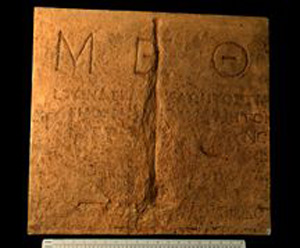Plaster Cast: Res Gestae, Greek Inscription, First Panel
1900.12.0087
Detailed Images
Basic Information
| Artifact Identification | Plaster Cast: Res Gestae, Greek Inscription, First Panel (1900.12.0087) |
|---|---|
| Classification/ Nomenclature |
|
| Artist/Maker | Unknown |
| Geographic Location | |
| Period | Early Roman Empire |
| Date | 14 CE |
| Culture | Roman |
| Location | Not on Exhibit |
Physical Analysis
| Dimension 1 (Height) | 59.0 cm |
|---|---|
| Dimension 2 (Width) | 55.5 cm |
| Dimension 3 (Depth) | 3.6 cm |
| Weight | 11,432 g |
| Measuring Remarks | Under Review |
| Materials | Plaster |
| Manufacturing Processes | Cast |
Research Remarks
| Description | The inscription of the Res Gestae (Achievements) of Augustus is the longest and most important contemporary document to survive from antiquity. It commemorates his role as the founder of the Roman Empire in the words he chose to memorialize his acts. Augustus requested in his will that, after his death, his Res Gestae (Achievements) be displayed in front of his Mausoleum on the Campus Martius in Rome on two bronze pillars. The words used are the plural of pila in the Latin text and stele in the Greek text (both meaning pillar), but Suetonius in his life of Augustus, 101.4, written in the early 2nd century CE, calls them bronze tabulae (tablets). Thus the bronze text may have been inscribed on plaques attached to a presumably stone pier or one actually made of bronze. The bronze version did not survive but the text has been reconstructed from fragments of four copies, three in Galatia and one in Lydia: (1) The relatively complete Latin text with Greek translation found on the Ankara temple. (2) A fragmentary Latin text from Psidian Antioch, near Yalvaç, inscribed on the sides of the central passage of a triple arched and stepped gateway (dedicated to Augustus). This leads to a colonnaded square with a small distyle prostyle temple on a podium in the center of a colonnaded hemicycle opposite the entrance arches. The fragments are now in the Yalvaç museum. (3) A fragmentary Greek translation found on the acropolis of Apollonia, modern Uluborlu, on a large base (ca. 4.45 m. long) for five statues including Germanicus, Tiberius, and Augustus with the Res Gestae located below the molding at the top of the base inscribed in seven columns of text. Much of the inscription recorded by earlier travellers has been lost but what remains is now housed in the Afyon museum. (4) A fragment of a Greek translation found at Sardis inscribed on a wall, probably of a temple of Augustus. This is the first copy of the Res Gestae found outside of Galatia and differs from the translations at Ankara and Apollonia, indicating that the translations were locally made. The inscription fragment is housed in the Sardis museum. |
|---|---|
| Published Description | N/A |
| Bibliography | CIL vol. III, pars 2, nos. 774–776 = Corpus Inscriptionum Latinarum, vol. III, Northern and Eastern Provinces of the Empire (including Asia Minor), pars 2, nos. 774–776. |
Artifact History
| Credit Line/Dedication | N/A |
|---|---|
| Reproduction | yes, Original casts made by Carl Humann in 1882 commissioned by Theodor Mommsen for the Berlin Academy and now stored in a depot of the Berlin Pergamon Museum. Cast made by staff of the Berlin Museum from molds made from the original casts made in Ankara. |
Contact
All information about our collection is constantly reviewed and updated. Please contact Dery Martínez-Bonilla, Registrar, if there is any information you are looking for that isn't currently online.
